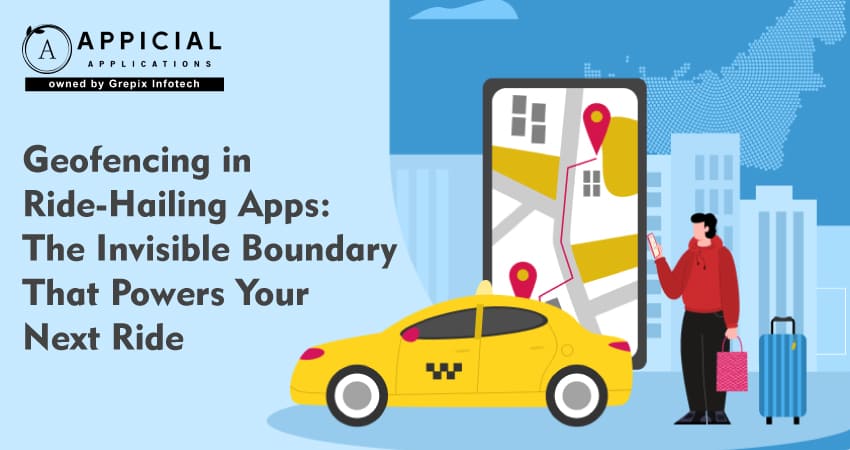
Geofencing in Ride-Hailing Apps: The Invisible Boundary That Powers Your Next Ride
You're waiting at a crowded airport terminal, phone in hand, ride-hailing app open. Even before you've considered walking to the pick-up area, your app instructs you where to go. A car is already en route, and you haven't had to tap a single key.
It feels like magic. But behind this effortless experience is an aggressive technology geofencing. Geofencing is the virtual equivalent of drawing invisible fences on a map. These virtual boundaries enable software to initiate pre-configured actions when a mobile device moves in or out of a target zone. Ride-hailing services bank on it to streamline operations, increase driver productivity, and optimize customer experience.
The idea isn't new. Geofencing has been used by marketers to send location-based offers for years. But in the ride-hailing world, it's revolutionary.
With scores of thousands of drivers and riders navigating cities by the hour, being able to manage, track, and maximize activity within a specific perimeter brings unprecedented insight to what would otherwise be a chaotic organization. In ride-hailing, geofencing enables firms to map out driver zones, control spikes in demand, optimize pick-ups and drop-offs, and even implement geographically based automatic pricing.
Geofencing is more than just a GPS trick, it’s a transformative tool for the ride-hailing industry. By creating virtual boundaries, apps can guide drivers, regulate pick-up zones, enable geo-based dispatch, and integrate intelligent taxi app features that improve both efficiency and user satisfaction. This blog explored how geofencing helps manage busy hubs like airports, encourages smart driver placement through driver zones, and supports location-based pricing strategies.From improved safety protocols in high-risk areas to real-life success stories at major events and transport centers, it’s clear that geofencing is essential to modern mobility solutions. As ride-hailing platforms evolve, so will their reliance on this dynamic technology, paving the way for smarter, safer, and more efficient travel experiences.
Use Cases in Taxi Apps
Let’s break down how geofencing drives the modern ride-hailing experience. Taxi app developers leverage this feature in multiple creative ways to solve real-world problems. Here are some of the most practical use cases:
1 Driver Zones Management
When a city is divided into logical driver zones, the app can assign drivers based on location rather than proximity alone. This organization ensures a balanced assignment of drivers to high-demand locations and avoids driver congestion in one area.
For instance, at peak hour in a densely populated business area, if ten motorists swarm the same corner, several will sit idle while demand elsewhere surges. With driver zones, apps can proactively guide drivers to underserved neighborhoods or business hubs. It’s a strategy that keeps the fleet balanced and earnings consistent.
2 Geo-Fenced Airports and Event Spaces
Airports, stadiums, and convention centers are hotbeds of ride requests but also regulatory nightmares. The majority of these places have regulations regarding where rides start and end.
Geofencing in ride-hailing app platforms in following these rules by restricting pick-up or drop-off locations to approved spaces.
If you’ve ever requested a ride from a busy airport and were guided to a specific “Rideshare Pick-Up Zone,” that’s geofencing at work. Drivers can't receive ride requests unless they're within the designated boundary, ensuring orderly operations and regulatory compliance.
3 Automated Geo-Based Dispatch
Incorporating geo-based dispatch algorithms allows the app to automatically pair riders with drivers inside the same geofencing area. This not only reduces wait times but also improves efficiency by minimizing deadhead miles (distance a driver travels without a passenger).
Apps use geo-based dispatch to speed up the matching process. Since drivers and riders are within the same virtual zone, they get paired faster, which makes the whole ride experience feel snappy and effortless.
4 Dynamic Pricing Based on Location
Geofencing supports demand-based pricing (also known as surge pricing) in a defined region. If there is a sudden surge in ride requests within a particular perimeter let's say after a concert concludes the app can automatically raise prices to prompt more drivers to come into that area.
It guarantees supply to match demand without recourse to manual adjustments. Riders get matched faster, and drivers earn more for their time.
5 Enhanced Safety Features
In risky areas or fraud-prone locales, geofencing can be used to add extra authentication steps or turn off specific capabilities. For example, a ride-hailing service can block cash payments in places where there have been numerous cash-related accidents.
Safety boundaries also ensure riders and drivers only connect in pre-approved, monitored areas. That kind of control fosters trust across the platform.
Implementation Steps
Geofencing is lovely for its simplicity. But as with any advanced tech feature, the right implementation takes careful planning, good backend design, and knowledge of what users do. Here’s how ride-hailing platforms usually integrate geofencing:
1 Define Strategic Locations
Start by identifying zones that require control or optimization. For example, airports, city centers, transit stations, malls, or entertainment venues. These locations become the primary candidates for geofencing.
2 Map the Virtual Boundaries
Using tools like Google Maps API, Mapbox, or OpenStreetMap, developers draw geofences as polygons or circular perimeters. A circular geofence is easier to implement but less precise. Polygon shapes, while more complex, offer better accuracy, especially in urban environments with irregular layouts.
3 Monitor Real-Time Device Location
For geofencing to work, the app needs to monitor the user's device's real-time GPS location. That is why users are asked to activate location services every time they launch any ride-hailing app. The GPS pings are then compared with the geofence data to determine entry or exit.
4 Trigger App Responses
When the app identifies a user entering or leaving a geofencing area, it initiates an appropriate action, enabling ride requests, allocating pick-up points, pricing modifications, or sending in-app alerts.
All of this takes place behind the scenes, but its impact on user experience is instant and tangible.
5 Integrate With Other Taxi App Features
Geofencing doesn’t operate in a vacuum. It needs to sync smoothly with the app’s broader ecosystem, including geo-based dispatch, pricing modules, driver analytics, and customer support tools. A properly integrated geofence system helps harmonize all these taxi app features to function like a well-oiled machine.
Benefits to Drivers & Admin
A well-implemented geofencing system doesn’t just improve user experience—it makes life easier for everyone involved in ride-hailing. From the gig worker behind the wheel to the admin monitoring operations in real-time, the advantages ripple across the board.
For Drivers
- Optimized Workloads: Drivers can avoid oversaturated areas and focus on locations where demand is steady and supply is low.
- Increased Earnings: With driver zones and dynamic pricing, they can earn more by simply being in the right place at the right time.
- Less Guesswork: Instead of driving around hoping for requests, drivers receive suggestions on where to go next based on location intelligence.
- Streamlined Pick-Ups: At places like airports or malls, drivers don’t have to guess where the rider might be. The app routes both parties to a common geofenced pick-up spot, saving time and confusion.
For Admins and Platform Owners
- Real-Time Operational Control: Admins can track activity by zone in real-time and make informed decisions on the fly.
- Compliance Simplified: Geofences ensure the platform is complying with local regulations, particularly in sensitive zones such as airports.
- Data Insights: With precise data on movement flow, heatmaps, and user clustering, platform owners can predict demand, plan promotions, or re-optimize supply zones accordingly.
- Cost Reduction: With better control over where drivers operate, platforms can cut down on wasted miles, reduce support issues, and optimize server loads for geolocation data.
Real Scenarios
Let’s zoom into some real-life examples where geofencing helped solve complex problems or improve efficiency in ride-hailing platforms.
Also Read: Geofencing in Taxi Apps: What It Is and How to Use It
Scenario 1: Curbside Pick-Up at JFK Airport
New York's JFK airport has a reputation for traffic jams and stringent ride-share policies. A major ride-hailing service encountered increasing complaints from drivers and riders who found it difficult to find one another in the midst of the jammed airport.
Solution? They implemented geofencing. By establishing a dedicated driver waiting zone and a tightly defined passenger pick-up area, the company managed to:
- Reduce pick-up time by 27%
- Increase successful matches by 35%
- Slash complaints related to missed connections by 60%
Drivers would only receive ride requests if they entered the geofenced staging lot. Riders, in turn, were guided by the app’s map to a clearly marked geo-based dispatch point. The result was smoother operations, less traffic, and higher satisfaction on both ends.
Scenario 2: Managing a Surge After a Stadium Event in London
When a major football match ended at Wembley Stadium, the local streets flooded with tens of thousands of fans, all pulling out their phones at once.
Thanks to pre-configured geofencing, the ride-hailing app had already anticipated the spike. Before the match even ended, it pushed out notifications to idle drivers in nearby driver zones, alerting them to potential surge pricing. At the same time, the app raised fare multipliers within the Wembley geofence, encouraging more drivers to enter that specific region.
The outcome?
- 50% faster ride allocation
- 42% higher driver earnings in that zone
- Zero system crashes, thanks to load-balancing between zones
Scenario 3: Cash Restriction in High-Risk Area in Manila
In certain neighborhoods in Metro Manila, cash-based rides posed a security risk. The ride-hailing platform used geofencing to disable the “cash” option for both riders and drivers within the predefined risk zone.
The platform added a safety advisory and enforced digital payment for trips that began or ended in that area. Since implementation:
- Incident reports dropped by 33%
- Rider trust metrics increased
- Drivers reported feeling safer
It was a small but powerful use of geofencing, directly tied to enhancing safety.
Conclusion
The next time you tap your ride-hailing app and a car appears almost like magic, remember geofencing is working silently in the background, making sure everything runs like clockwork.
From optimizing driver zones to powering geo-based dispatch, geofencing plays a central role in delivering a frictionless experience. It’s not just a technical add-on it’s one of the most essential taxi app features of the modern mobility ecosystem.
For developers, it’s a tool that offers both control and creativity. For drivers, it’s a path to higher earnings and smarter navigation. And for riders, it’s what turns urban chaos into coordinated convenience.
As ride-hailing technology continues to evolve, geofencing will remain at the heart of innovation, quietly redefining how cities move, one virtual boundary at a time. To incorporate geofencing in ride-hailing apps, visit Appicial Applications today!
Looking out to start your own venture like Uber ? Try out our HireMe Taxi Uber Clone, the easiest way to kick-start your taxi business.Author's Bio

Vinay Jain is the Founder at Grepix Infotech and brings over 12 years of entrepreneurial experience. His focus revolves around software & business development and customer satisfaction.
Back to blog list




